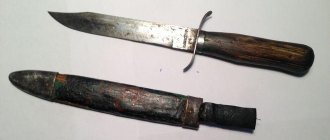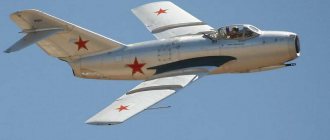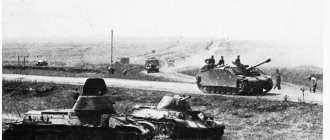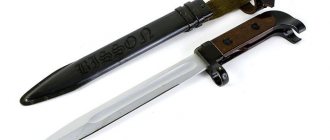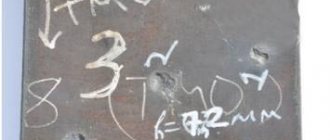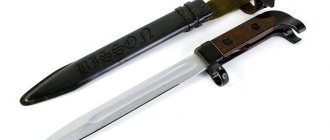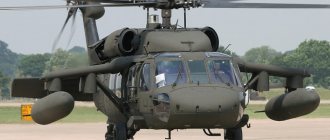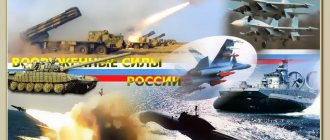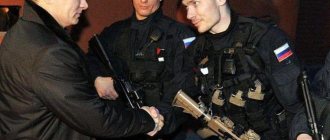Years pass... the hard times of war are becoming a thing of the past, and fewer and fewer Veterans remain with us - witnesses and participants in the fiery hell that befell them. But time is unable to erase the military and labor feats of the people in human memory. We are proud that the Ural people at the camps in the rear and at the forefront made a significant contribution to the Victory, to the common cause of the entire Russian people. In honor of the celebration of the 69th anniversary of the Great Victory of the Russian people over the Nazi invaders, we publish material about the formation and combat path of a unique military formation - the Ural Volunteer Tank Corps, nicknamed by the Germans the “black knives” division.
HAPPY HOLIDAYS! ETERNAL MEMORY TO HEROES!
History of creation
In 1942, when the Battle of Stalingrad was taking place on the battlefields, a proposal was born in the working groups of the Sverdlovsk tank-building factories: to make a gift to the front - to create their own, Ural, tank formation. At the initiative of tank builders, the newspaper “Ural Rabochiy” dated January 16, 1943 published an article “Tank Corps - Above Plan”: tank builders of the Urals pledged to exceed production plans for the production of military products, work for free and regularly deduct part of their earnings to equip the corps with combat vehicles , weapons, uniforms. The patriotic initiative of Sverdlovsk residents was picked up by the Chelyabinsk and Molotov regions. A letter was sent to the Chairman of the State Defense Committee, which stated:
“...Expressing the noble patriotic desires of the Urals people, we ask you, Comrade Stalin, to allow us to form a special volunteer Ural Tank Corps in your name in honor of the 25th anniversary of the Red Army...”
On February 24, 1943, a response telegram arrived from Moscow:
“YOUR PROPOSAL TO FORM A SPECIAL VOLUNTEER URAL TANK CORPS IS APPROVED AND WELCOME. THE ORDER HAS BEEN GIVEN TO THE GABTU TO PROVIDE YOU WITH ASSISTANCE IN SELECTION OF COMMANDS. J.STALIN."
On the very first day after receiving Comrade Stalin’s telegram, a stream of applications poured into the military registration and enlistment offices from volunteers, boys and girls, men and women, who wanted to become soldiers of the corps. More than 100 thousand applications were submitted by factory workers. 12 people applied for one place in the corps. Commissions were created at enterprises and military registration and enlistment offices. They selected physically strong, healthy people who knew how to operate equipment and those whose specialties were applicable in tank forces. 9,660 people were selected for the corps out of 115 thousand who applied. At the same time, voluntary fundraising for the fund for the creation of the corps continued throughout the Urals. We collected over 70 million rubles. This money was used to buy military equipment, weapons and uniforms from the state. Based on local conditions and resources of the regions, formations and corps units were formed in Sverdlovsk, Molotov, Chelyabinsk, Nizhny Tagil, Alapaevsk, Degtyarsk, Troitsk, Miass, Zlatoust, Kus and Kyshtym. The 30th Tank Corps was formed in a surprisingly short time. By order of the People's Commissar of Defense of March 11, 1943, it was given the name - 30th Ural Volunteer Tank Corps. The material part of the hull consisted of: T-34 tanks - 202, T-70 - 7, BA-64 armored vehicles - 68, self-propelled 122-mm guns - 16, 85-mm guns - 12, M-13 installations - 8, 76-mm guns mm - 24, 45 mm guns - 32, 37 mm guns - 16, 120 mm mortars - 42, 82 mm mortars - 52.
Thus, the state did not spend a single ruble on the creation of such a large-scale unit within the army as a corps; all military equipment and weapons were prepared either on its own or were purchased from funds accumulated by the workers. The Ural Tank Corps became the only volunteer unit of its kind on such a large scale. Later, from the recollections of German soldiers, one can safely conclude that the Ural people showed exceptional bravery, courage and sometimes recklessness in battle, which made the Germans afraid of military clashes with Ural tank crews.
Combat path. Operations.
During the Great War, the Ural Corps took part in the following military operations:
July 27 – August 29, 1943: Oryol operation; March 4 – April 18, 1944: Proskurov-Chernivtsi operation; July 14 – August 12, 1944: Lviv-Sandomierz operation; January 12 – 31, 1945: Vistula-Oder operation; February 8 – 22, 1945: Lower Silesian operation; March 8 – 31, 1945: Upper Silesian operation; April 16 – May 2, 1945: Berlin operation; May 6 – 9, 1945: Prague operation
The corps took its first battle on July 27, 1943 in the second phase of the Battle of Kursk. And just three months after entering into combat, by order of the People's Commissar of Defense of the USSR No. 306 dated October 26, 1943, the 30th Ural Volunteer Tank Corps was transformed into the 10th Guards Ural Volunteer Tank Corps for the bravery of the soldiers and tank crews shown in battle. All units of the corps were given the name Guards. In 1944, for participation in hostilities on the territory of Ukraine, in the operation to liberate the city of Lvov from Nazi troops, the corps was awarded the honorary name “Lvov”. Awarded the Order of the Red Banner, the Order of Suvorov II degree, the Order of Kutuzov II degree.
Tankers took an active part in the liberation of many European cities, confronted the elite divisions of the Germans, from which they emerged victorious, however, not without losses. Throughout the entire period of hostilities, the corps was periodically withdrawn for rest and replenishment, the corps' combat losses were significant - a terrible price for courage and dedication.
During the two years of participation in the Great Patriotic War, the Ural Volunteer Tank Corps traveled from Orel to Prague over 5,500 kilometers, of which 2,000 kilometers were in battle.
The corps liberated hundreds of cities and thousands of settlements from the Nazi invaders, and rescued tens of thousands of people from Hitler’s slavery. 1,220 tanks and self-propelled guns, 1,100 guns of various calibers, 2,100 armored vehicles and armored personnel carriers, 15,211 motor vehicles, 589 flamethrowers were captured and destroyed, 94,620 enemy soldiers and officers were destroyed, 44,752 Nazis were captured.
Black knife.
The 10th Ural Volunteer Tank Corps had another name, invented by the Germans. It sounded like this: Schwarzmesser Panzer–Division or translated into Russian “Black Knives Division”. This is because the UDTK tankers, from privates to commanders, owned “black knives.” “Black knife” is the popular name for an army knife of the 1941 model, produced by the Zlatoust tool factory during the Great Patriotic War. In shape, the “black knife” was a Finnish-style knife with a straight single-edged blade, a wooden handle with a small flat iron guard and a wooden sheath. The handle and scabbard were coated with black varnish, and the iron fittings of the scabbard and guard were blued - hence the name. The knives were valued for their great strength and sharpness of the blade and were intended to equip scouts and paratroopers. In some intelligence units, the "black knife" was awarded to recruits only after taking several "tongues" or other combat tests. During the formation of the Ural Volunteer Tank Corps in 1943, each soldier and commander received a “black knife” as a gift from the Zlatoust gunsmiths.
German intelligence immediately drew attention to this feature in the equipment of the Ural tank crews. The Soviet soldiers knew about their nickname and were not ashamed of anyone; on the contrary, they were proud that the enemy had singled out only their unit from among many, which means they were really afraid of the “black knives”. During the war, a song about “black knives” appeared written by Ivan Ovchinin, who later died in the battles for the liberation of Hungary. The “black knife” is also mentioned in the “March of the Ural Volunteer Tank Corps”. In small batches, the plant also produced an officer version of the “black knife”, intended mainly for awards and gifts and distinguished by chrome-plated parts on the handle and sheath. Decorated knives along with checkers were presented during the Great Patriotic War to the Supreme Commander-in-Chief I.V. Stalin and Marshal of the Soviet Union G.K. Zhukov. The Ural Volunteer Tank Corps was the only unit that officially had its own symbol - the “black knife”, a distinctive detail that set the Uralians apart from the entire Red Army.
Today, the “black knife” is very rare and therefore valued among collectors. However, getting a real knife is extremely difficult, since the owners who inherited the relic are in no hurry to monetize the memory.
Feats.
The first Hero of the Soviet Union was the tank commander of the 61st Guards Sverdlovsk Tank Brigade, Grigory Sergeevich Chesak, who knocked out three “tigers” in one battle. On the approaches to Kamenetsk-Podolsk, miracles of heroism were again shown by the soldiers of the brigade, when at top speed, with headlights on, firing from cannons and machine guns, they burst into the village of Zinkovtsy. The stunned enemy fled in disarray, leaving behind their equipment and weapons. The archives of the Ministry of Defense contain lists of tankers who had ten or more destroyed tanks, self-propelled guns and armored personnel carriers on their personal account. There are 60 such battle masters in three tank brigades: in the Sverdlovsk - 32 (destroyed a total of 534 enemy armored units), in the Perm - 14 people (196 armored units) and in the Chelyabinsk also - 14 (a total of 161 armored units). In total, these 60 corps tankers knocked out and destroyed 901 armored units of the Wehrmacht, of which 379 were tanks, 225 self-propelled guns, 296 armored personnel carriers. Of these sixty, thirty-five destroyed from 10 to 15 enemy armored units each, thirteen - from 16 to 19, and Twelve tank guardsmen have 20 armored units or more. These were outstanding masters of tank combat, operating with especially well-coordinated crews. For excellent military operations, heroism, courage and bravery of the Ural volunteers, the Supreme Commander-in-Chief expressed gratitude to the corps and its units 27 times. The soldiers of the corps were awarded 42,368 orders and medals, 27 soldiers and sergeants became full holders of the Order of Glory. 38 guardsmen of the corps were awarded the title of Hero of the Soviet Union. There are 15 corps units on the banners - 54 orders.
As you can see, many fighters and commanders of heavy vehicles performed military feats, but I would like to tell you about one story in more detail. To celebrate the feat of Ivan Goncharenko and how the descendants of the grateful residents of liberated Prague said “thank you”!
Since 1944, Ivan Goncharenko commanded a tank as part of the 63rd Guards Tank Brigade of the Ural Volunteer Tank Corps. Goncharenko’s crew distinguished themselves in the battles for the liberation of Ukraine and Poland, and took an active part in the battles for Berlin. At the end of April 1945, the outcome of the war was already a foregone conclusion, but not all German units were willing to surrender. So the garrison that occupied Prague firmly and reliably settled on the streets of the ancient city. Residents of Prague revolted and the Red Army sent infantry and armored units to help the rebels. Before the assault, Ivan Grigorievich’s crew was assigned to a tank reconnaissance platoon, staffed by Chelyabinsk tankers, which was tasked with breaking into the entrenched German camp and recapturing the strategically important bridge across the Vltava River. The T-34-85 crew number 24 included: on the right:
I. G. Shklovsky - senior mechanic-driver
I. G. Goncharenko - commander (lieutenant) P. G. Batyrev - gun commander A. N. Filippov - radio operator
On the morning of May 9, 1945, when Victory was already being celebrated somewhere, the tankmen of the Chelyabinsk Tank Brigade took on a battle from which not everyone was destined to return. The fighters from the crew of Ivan Goncharenko became the first Soviet soldiers to break into the last citadel of the Reich - the capital of the Czech Republic, the beautiful city of Prague, held by the last forces of the Germans. The best account of the events of that morning is an extract from Ivan Grigorievich’s posthumous award list:
“Acting in the lead patrol, inflicting crushing blows on the enemy, Comrade Goncharenko was the first to break into Prague. Swiftly pursuing the enemy, Comrade Goncharenko captured the bridge over the Vltava River in the center of the city and entered into an unequal battle with 13 German self-propelled guns. While holding the crossing, Comrade Goncharenko destroyed 2 self-propelled guns with the fire of his tank. The tank was hit by a shell and caught fire. T. Goncharenko was seriously wounded. Being seriously wounded, the brave officer, bleeding, continued to fight. Comrade Goncharenko was killed by a second hit in the tank. At this time, the main forces arrived and began a rapid pursuit of the enemy. For his demonstrated perseverance, courage and bravery in battle, he is worthy of the government award of the Order of the Patriotic War, 1st degree.”
Goncharenko was buried on the outskirts of Prague, not far from the place where he died... on Victory Day, to which he walked hundreds of “fiery kilometers.” Later, his ashes were reburied in the fraternal cemetery of Soviet soldiers who died for the liberation of Czechoslovakia in Olshany. A memorial sign was erected at the site of the death of Ivan Goncharenko. In honor of tank No. 24, as the first to break into besieged Prague, a monument to the IS-2M (Monument to Soviet tank crews) was erected; the original tank No. 24 could not be preserved. In the eighties, after a “reassessment of values” by the residents of Prague, whose grandfathers welcomed Soviet soldiers who came to help in the fight against the German invaders, the tank was dismantled from its pedestal. But the suffering of the combat vehicle did not end there; in another action against the Soviet Union, the residents of Prague completely “abused” the combat vehicle - a monument not only to the feat of I.G. Goncharenko, but also to all Soviet wars, without whose help the residents of Prague were doomed to mass terror - painting the tank pink... desecrating the memory of the heroism of a common man who was fulfilling his military duty. The Prague authorities, of course, responded to the emergency, but in their opinion, the action was not of a “government nature” and was classified as hooliganism. In the name of I.G. Goncharenko named streets in Prague (Gončarenkova, Praha 4) and in Chelyabinsk. His native village was renamed Goncharenkovo.
In memory of the feat of arms of the Ural tank crews, monuments were erected in Berlin and Steinau (Poland), in Lvov and Kamenetsk-Podolsk, in Sverdlovsk and Perm, Chelyabinsk and Nizhny Tagil, other small towns of the Urals and in many settlements that were liberated by volunteers. The Yekaterinburg motorcycle club “Black Knives” is named after the 10th Guards Ural Volunteer Tank Corps. The names and military exploits of volunteer tank crews who died in battles are inscribed in golden letters in the history of the Second World War.
Post-war days and our time.
Since the fall of 1945, the military glory of the corps that ended the war in Prague was inherited by the soldiers of the 10th Guards Ural-Lvov, Order of the October Revolution, Red Banner, Order of Suvorov and Kutuzov volunteer tank division, which was stationed in East Germany, in the city of Altengrabov. Continuing the glorious combat traditions of older generations, the personnel of the division achieved that for many years it was considered the best formation of the Group of Soviet Forces in Germany. For high results in combat training, the division was named after Marshal of the Soviet Union R.Ya. on June 16, 1967. Malinovsky, and on February 21, 1978 she was awarded the Order of the October Revolution. In 1994, according to the decision of the Government of the Russian Federation, the 10th Tank Division was the last to leave the territory of the Federal Republic of Germany and was redeployed to the city of Boguchary, Voronezh region. This movement, unprecedented on a peacetime scale, was carried out in combined marches between November 1993 and July 1994.
Having existed until 2009, the division was disbanded, and a storage base was formed on its base, preserving the nominal banner of the 10th Ural Volunteer Tank Division. The banner of the division and its constituent units was placed in the hall of military glory in Moscow.
Despite the fact that the Ural Volunteer Corps no longer exists, the memory of glorious exploits is still preserved by descendants and every May 9, combat vehicles of the Ural Volunteer Tank Corps drive out to the central squares of the cities of the Urals, with the clanging of their tracks reminding that only 69 years ago this clang guaranteed life and freedom for all of us. Eternal memory to the heroes! HAPPY HOLIDAYS!!!
Andrey Lyubushkin “Mysterious Ural”
Additional information on the topic.
The “Black Knives” division was withdrawn from the Altengrabovsky training ground to the Voronezh region.
During the Great Patriotic War, starting in 1941, 3,356 Finnish knives were produced specifically for the Ural Volunteer Tank Corps. These short, heavy blades with black handles, which were in service with our tank crews, inspired fear and respect in the enemies.” “Schwarzmesser Panzern Division” - tank division “Black Knives” - this is what German intelligence called the Ural Corps on the Kursk Bulge in the summer of 1943. Black knife is the popular name for an army knife of the 1941 model, produced by the Zlatoust Tool Factory during the Great Patriotic War. In shape, the “black knife” was a Finnish-style knife with a straight single-edged blade, a wooden handle with a small flat iron guard and a wooden sheath. The handle and scabbard were coated with black varnish, and the iron fittings of the scabbard and guard were blued - hence the name. The knives were valued for their great strength and sharpness of the blade and were intended to equip scouts and paratroopers. In some intelligence units, "black knives" were awarded to recruits only after taking several "tongues" or other combat tests.
During the formation of the Ural Volunteer Tank Corps in 1943, each soldier and commander received a “black knife” as a gift from the Zlatoust gunsmiths. This feature in the equipment of the Ural tank crews was immediately noticed by German intelligence, which gave the corps its name - “Schwarzmesser Panzern Division” - “Black Knife” tank division. The corps' amateur jazz orchestra often performed for the soldiers the “Song about the Black Knives,” the music for which was written by Ivan Ovchinin, who later died in the battles for the liberation of Hungary. The “black knife” is also mentioned in the “March of the Ural Volunteer Tank Corps”. The plant also produced an officer version of the “black knife” in small batches, intended mainly for awards and gifts and distinguished by chrome-plated parts on the handle and sheath. Decorated knives along with checkers were presented during the Great Patriotic War to the Supreme Commander-in-Chief I.V. Stalin and Marshal of the Soviet Union G.K. Zhukov.
Song about black knives
The song was written in 1943 in the Bryansk forests after the first operation carried out by the corps.
Words by R. Notik. Music by N. Komm and I. Ovchinin
The fascists whisper in fear to each other, Hiding in the darkness of the dugouts: Tankers have appeared from the Urals - the Black Knife Division.
Selfless warriors are detachments, Their courage cannot be killed by anything. Oh, the fascist bastards don’t like our Ural steel black knife!
As the machine gunners jump from the armor, you won’t be able to take them down with any fire. Volunteers cannot be crushed by an avalanche, After all, everyone has a black knife.
Huge Ural tanks are rushing, making the enemy's force tremble, Oh, the fascist bastards don't like our Ural steel black knife!
We will write to the gray-haired Urals: “Be confident in your sons, It was not in vain that we were given daggers, So that the Nazis would be afraid of them.”
We will write: “We are fighting as we should, And the Ural gift is good!” Oh, the fascist bastards don’t like our Ural steel black knife!
Material from Wikipedia - the free encyclopedia.
| 10th Guards Tank Ural-Lvov Order of the October Revolution Red Banner Orders of Suvorov and Kutuzov Volunteer Division named after Marshal of the Soviet Union R. Ya. Malinovsky | |
| Awards: | |
| Honorary titles: | Ural-Lvovskaya |
| Troops: | Ground troops |
| Type of army: | |
| Formed: | 1943 |
| Disbanded (reformed): | current |
| Predecessor: | Special Ural Volunteer Tank Corps named after I.V. Stalin (from February 26, 1943) 30th Ural Volunteer Tank Corps 10th Guards Ural Volunteer Tank Corps (from October 26, 1943) |
| Combat areas | |
| Oryol operation, Proskurov-Chernivtsi operation, Lvov-Sandomierz operation, Vistula-Oder operation, Lower Silesian offensive operation, Upper Silesian offensive operation, Berlin offensive operation, Prague operation | |
10th Guards Tank Ural-Lvov Order of the October Revolution Red Banner Orders of Suvorov and Kutuzov Volunteer Division named after Marshal of the Soviet Union R. Ya. Malinovsky (abbr. 10 Guards TD) - tank formation of the Armed Forces of the Soviet Union (Ground Forces of the Russian Federation), which hosted participation in the Great Patriotic War.
History of the tankman's knife
During the Great Patriotic War, Stalin allowed the organization of a tank corps in the Urals. However, the state did not finance it in any way. In those days, people were true patriots of the Motherland and did not regret everything they had.
Ordinary people were collected:
- technique;
- outfit;
- money.
The work collectives of Sverdlovsk wanted to give the soldiers a tank unit. Tank builders performed the following actions:
- exceeding production plans for the manufacture of military products;
- unpaid work;
- deduction of part of the salary for the body of a combat vehicle and weapon.
This body was assembled very quickly. Out of 115,000 applicants, only 9,600 people were selected. The competition was huge. The best fighters have passed.
A total of 54.5 million rubles were collected in the following cities:
- Chelyabinsk – 10,000,000;
- Zlatoust – 7000000;
- Magnitogorsk – 6,500,000.
The case included:
- T-34 tanks - 202 pcs.;
- “T – 70” - 7 pcs;
- armored vehicles "BA-64" - 68 pieces;
- self-propelled 122 mm guns – 16 pcs;
- guns 85 – mm – 12 pcs;
- installations "M-13" - 8 pieces;
- guns 76 – mm – 24 pcs.;
- guns 45 – mm – 32pcs;
- guns 37 -0mm – 16 pieces;
- 120 mm mortars – 42 pcs;
- 82 mm mortars – 52 pcs.
Tankman's knife.
The courage of the Ural tank crews glorified the “black” knife. After the Finnish War, the Soviet army was armed with it. It began to be produced in 1942.
The first sample was released 2 weeks later. According to the documents, it was designated as “type N-41” or “dagger knife”.
In the third quarter of 1942, 47,300 pieces were produced, and in the fourth - 186,800. In 1943, 1,000,000 were produced.
New in blogs
Black Knife Division “The Nazis whisper in fear to each other, Hiding in the darkness of the dugouts: Tankers have appeared from the Urals - the Black Knife Division.”
(From a song of the Ural Volunteer Tank Corps)
Mark of the Zlatoust Tool Plant (ZiK) on the NA-40
IN THE HISTORY of domestic edged weapons, there are few examples that cause so much controversy and disagreement. One of the most “disputed” is the 1940 army knife, or in other words, the Red Army Finnish knife, a scout knife. Who owns the “copyright” of the deadly blade? The army as a whole, or maybe reconnaissance or landing forces? Is it even correct to call this knife “Finnish”? In the traditional “Special Forces” section, we talk about the history of the “king” of close combat.
Army knife model 1940 NA-40 by I.L. Efroikin - Secretary of the Central Committee of the Young Communist League for Propaganda
It all started... with a puukko
A FINNISH knife, or colloquially a finka, is a special type of knife that was widely used first in the Russian Empire and then in the Soviet Union. The name comes from the fact that the prototypes of these knives were originally made in Finland. There, the traditional household knife bears the original name puukko. It was used in everyday life by residents of Scandinavia and the adjacent part of northern Russia back in the Middle Ages. In almost unchanged form, this version of the knife exists to this day.
By the way, Swedish and Norwegian knives have a similar shape. Their popularity in pre-revolutionary Russia was such that any knives with a straight blade and a beveled edge were popularly called Finnish. This is not entirely true. It should be remembered that the original form of the puukko is somewhat different from the one that we now firmly associate with the Finnish woman. What are the differences? The puukko does not have a protective guard in any form - S-shaped or in the form of a straight bar, as well as fullers called blood flows. A powerful stabbing blow was delivered due to the grip of the blade, determined by the ergonomics of the handle. The butt of the blade made it convenient to use it with a rest at the base of the palm.
The Bolsheviks made the criminal knife a reward
COMPACT size, ease of use, and high efficiency made the finca widespread throughout the Russian Empire. But first of all, it became popular in the criminal environment.
In addition to Finland, knives were produced in St. Petersburg, Moscow, Tula and the village of Vacha in the Nizhny Novgorod region. Kondratov's knife production in Vacha, founded in 1830, later became famous under the brand name. Of course, in addition to large-scale production, knives were made in hundreds of small workshops or even in a handicraft way.
After the 1917 revolution, most small businesses were closed. But the popularity of the Finnish knife has not waned. On the contrary, the Finnish woman unexpectedly changed her “status”. From a criminal knife, used only by bandits and robbers, it suddenly turned into a reward and almost ceremonial weapon. The Bolsheviks, who came to power, knew well about the merits of the Finnish woman - that’s why they transferred her to the honorary category. Knives began to be decorated with dedicatory engravings, and the handles were carefully decorated with inlaid plates made from a variety of materials.
Soviet special forces soldiers went on reconnaissance missions with the Finnish woman
But the passing of bladed weapons from one hand to another was not welcomed. In 1935, the carrying and possession of Finnish knives was even declared illegal. Except in special cases when there is permission from the NKVD.
In the People's Commissariat of Internal Affairs itself, Finns were used as personal edged weapons. It is possible that it was on the samples manufactured for the NKVD that the shape and size of the knife was worked out, which a little later became the classic army knife of the 1940 model.
Finks were widely used by Finnish units during the “winter war” of 1939-1940. Combat experience has shown the high effectiveness of these knives in close combat. When the leadership of the Red Army decided to rearm the soldiers by giving them submachine guns of the Degtyarev system of the 1940 model, they had to think about one-on-one action. I needed a knife that was not attached to the weapon. This "scheme" was also borrowed from the tactics of Finnish units. This is how the NA-40 model 1940 army knife was adopted by the Red Army. First of all, as a weapon for “submachine gunners,” as shooters armed with submachine guns were then called. In fact, the same knife was used by scouts under the name HP-40. The airborne troops had similar ones. A separate modification was made for the command staff of the Red Army. A similar blade, called the “army general’s knife of the 1940 model,” was distinguished by good finishing, a yellow handle and sheath. A knife based on the NA-40 was also used by units of the Separate Motorized Rifle Brigade for Special Purposes OMSBON NKVD, and since 1943 - by the Special Purpose Detachment OSNAZ NKGB - the forerunners of modern special forces.
The scabbard was painted black for camouflage.
NA-40 had several characteristic structural features. It was distinguished from the traditional puukko by the presence of a flat steel S-shaped guard, which had an original bend. From the side of the blade, the guard emphasis turned towards the blade, and not vice versa. The blade had a beveled butt - the so-called “pike nose”, without fullers. Most often, it was not protected from corrosion by bluing.
The handle and scabbard were usually made of wood and painted black for camouflage during night operations.
The wooden sheath was assembled and protected by a metal mouth and tip. The knife was worn on a leather or canvas sling on a waist belt on the left side at an angle of 30 degrees, with the handle pointing to the right. At the front, however, wooden scabbards were often replaced with homemade leather ones, as they were more comfortable to wear. In extreme war conditions, wooden sheaths quickly became unusable.
For the effective use of a knife, methodological recommendations were developed. Thus, techniques for working with a knife were included in the 1941 “Guide to Preparation for Hand-to-Hand Combat of the Red Army.” One of the well-known manuals is also N.N. Simkin’s brochure “Close Combat”, published by the Moscow Institute of Physical Education and Sports in 1944.
Knife of A.A. Prokopyev, deputy commander of the “Combat” special detachment, which operated in the Vitebsk region. Issued to him in December 1941 during the formation of a detachment in Moscow
"Tuning" in a guerrilla style
PRODUCTION OF NA-40 was established at several enterprises. The main ones among them were the already mentioned in the village of Vacha and the Zlatoust Tool Plant named after V.I. Lenin (ZiK). The bulk of knives were manufactured at these factories in 1942 - 1943. The production volumes are amazing: in Zlatoust in 1942 261,000 units were produced, in 1943 - 388,000. Knives were also made at army repair bases. Therefore, there are many knives, the general appearance of which is reminiscent of the statutory model of 1940, but is still somewhat different from it.
A continuation of the practice of “tuning”, widespread even in pre-revolutionary times, was again the use of inlaid handles made of plexiglass, bone, brass and other materials. In some cases, a plate with the owner’s name or some slogan could be installed inside the transparent or partially transparent handle. For example - “Death to the German occupiers!”
In battles with the Nazis, the knife proved to be a good weapon. Comfortable to wear and use, it has proven to be an excellent aid to many thousands of soldiers. More than one German sentry fell dead, struck by a Red Army soldier who crept up like a shadow.
Alas, a convenient and practical knife among the troops was not as widespread as it could have been. Modifications of the NA-40 were mainly used by reconnaissance officers. And many ordinary soldiers fought without bladed weapons. Although in conditions of desperate close combat, when death is at arm's length, a knife could save more than one life...
Knife of I.S. Shurman - commissar of the detachment named after. M.I. Kalinin 2nd Partisan Brigade named after. K.S. Zaslonova
Sergey LOPAREV,
Researcher at the collections department of the Belarusian State Museum of the History of the Great Patriotic War Photos from the museum collections
Photo from the museum's collections
Features of material and shape
The device is a finca with a straight single-edged blade. The handle was mainly made of wood. The scabbard is also wooden. An iron guard was present. The handle and scabbard were opened with black varnish. The blade was elongated.
The iron fittings of the scabbard and guard were blued. Every soldier and commander was given such a weapon in 1943. The knife was a mandatory element of the weapons of the corps fighters.
The first sample was the “Scout Knife” HP - 40. It was produced in Zlatoust at a tool factory. Product characteristics:
- weight without sheath – 150 g;
- total length – 26.3 cm;
- blade length – 15.2 cm;
- width -2.2 cm;
- butt thickness – 2.6 mm;
- steel grade – U7.
Black knife.
History of creation.
One of the variants of the “NKVD Finnish”. , 1930s.
In the early to mid-1930s, legislation regarding the circulation of bladed weapons was tightened in the RSFSR; a direct ban on the manufacture, storage, sale and carrying of Finnish knives appeared in the Criminal Code. At the same time, NKVD employees have been receiving, as a special tool, since 1935 a Finnish knife (in some documents a “Norwegian” or “Swedish type knife”), manufactured in several varieties (formerly a factory of the industrialist Kondratov) in the village of Vacha, Nizhny Novgorod region. The basis of the “NKVD knife” was a copy of a Swedish knife produced by P. Holmberg, which was banned as a “Finnish knife.” The knife was characterized by either a straight spine or a spine with a characteristic bevel - “pike”, fullers, and a Finnish type of handle head. A distinctive feature from the Finnish puukko was the developed curved guard, often S-shaped. An unsharpened heel was left on the blade in front of the guard, so that in some grips the index finger could be transferred to the blade. The handle was made of carbolite. The knife was not officially in service, but was issued as clothing allowance. From the 1930s to the end of the 1970s, he completed at least 6 large orders for similar knives.
The Soviet-Finnish War revealed shortcomings in the Red Army's armament. Among other conclusions, in 1940 the models of authorized edged weapons were revised, in particular, a new army knife was adopted for service. The alleged prototypes of the Soviet army knife are:
- Finnish uniform bayonet-knife of the 1919 model, designed by the artist Akseli Gallen-Kallela and produced by Fiskars - an eclectic model combining a blade with a lower spine line, fullers and a developed heel, a large S-shaped guard, a saber handle with a metal back, an all-metal sheath, repeating the curve of the puukko sheath, a large lanyard brush, borrowed from long-bladed weapons;
- Finnish scout knives (partiopuukko) - knives designed for boy scout organizations in different countries, with clear signs of American traditions - a double-sided (less often one-sided) guard stop, a blade with a predominantly beveled spine, a narrow or wide fuller. Scout models, purchased with personal funds, enjoyed some popularity among soldiers of the regular Finnish army and representatives of volunteer organizations.
- None of the models can be called the direct ancestor of the HP-40, although all elements of the knife, design and manufacturing technology are easily recognizable in the prototypes.
| Characteristics of a 1940 model army knife | |
| Total length of knife, mm | 263 |
| Blade length, mm | 152 |
| Maximum blade width, mm | 22 |
| Maximum butt thickness, mm | 2,6 |
| Blade material | Steel U7 |
| Handle material | Tree |
| Method of attaching the blade to the handle | Mounted through installation with riveting of the shank |
The blade has a beveled spine (“pike”, clip-point), the slopes occupy about half the width of the blade, and there is a pronounced heel in front of the guard for moving the index finger onto the blade. The most characteristic feature of the scout knife is the S-shaped crosshair of the guard, which has an unconventional bend: on the side of the blade, the guard stop is bent not towards the handle, but vice versa towards the blade. This unusual “inverted” guard is due solely to the combat orientation of the knife: the main grips were considered to be straight inverted with the blade directed upward (for bottom-up strikes to the abdomen and hypochondrium), or reverse (for top-down strikes to the neck area). In both grips, the knife lies in the hand “upside down” relative to the usual traditional position of the knife, therefore the guard received a corresponding bend. The handle and scabbard were made of wood and painted black (to avoid unmasking during night operations), but the blade was not blued or coated. It was recommended to carry the knife on the waist belt on the left side at an angle of 30°, with the handle to the right.
Use in combat
The weapon was intended:
- scouts;
- paratroopers;
- machine gunners.
The Zlatoust gun could be awarded if a newcomer passed a combat test. The devices were different:
- strength;
- sharpness. Black Knife Division.
It was first noticed by German fascists in battle near the village of Borilovo, Oryol region.
German intelligence officers reported the appearance of a wild division armed with unusual black knives.
They were also called Ural devils.
Modern analogues
At the present time there is an opportunity to purchase this option. Sometimes you can find the original at a closed auction. But in this case there are 2 disadvantages:
- very high price;
- possibility of purchasing a fake.
You can also buy a replica in online stores of official manufacturers. The sale is handled by the arms factory in the city of Zlatoust, which is the successor to ZIK.
Production was resumed in 2005. From a 1943 copy:
- Measurements were taken.
- Created a drawing.
- Recreated HP - 40.
Only one change was made in production. Reduced the thickness of the blade to 2.4 mm. This was done to meet the standards of knives for household use. The previous sample related to edged weapons. This is how the ability to sell the device appeared.
How to order black knives
If you need an exclusive black knife that is valued by collectors, contact the store. Here you can choose the best variant of edged weapons for you. To buy a black tankman knife, fill out the convenient feedback form on the page of the product you need. You will need to indicate: full name, delivery address and contact information.
Once the information is entered into our database, the store manager will check the availability of the product and contact you to agree on the details of the order. We deliver goods throughout Russia - Chelyabinsk, Zlatoust, Magnitogorsk and other cities. You can also contact our contact numbers for additional information. We will quickly answer any questions and help you choose black knives at competitive prices! We are waiting for your calls!
Bottom line
This weapon is the personification of courage and courage, as well as love for one’s Motherland. The device can be considered a national property. Thanks to the Zlatoust factory, the country’s glorious military history has not been forgotten.
Previous
National knivesKuyabrik knife - a rustic type weapon
Next
Making knivesVises for knife makers: how to make it yourself
